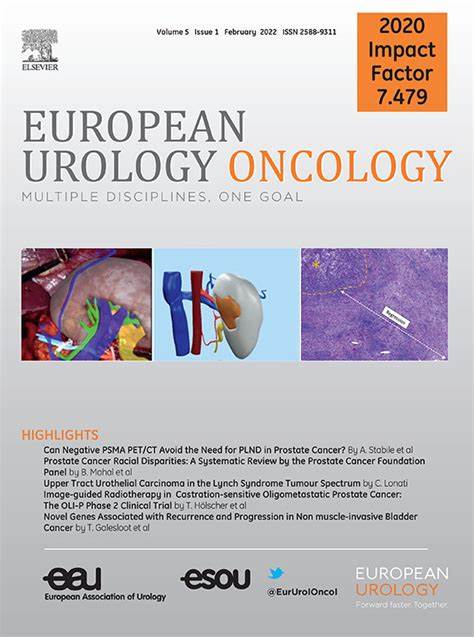前列腺癌和痴呆之间的关系:瑞典的一项全国性研究。
IF 9.3
1区 医学
Q1 ONCOLOGY
引用次数: 0
摘要
背景与目的:前列腺癌(PC)和痴呆可能共同发生;然而,双向关联的先前证据并不一致。本研究旨在通过大规模人群研究确定PC和痴呆之间的关系,这可能进一步为临床护理提供信息。方法:为了评估PC男性的痴呆风险,对1998-2017年瑞典诊断为PC的178 746名男性和1 787 460名年龄匹配、既往无痴呆的对照男性进行了一项全国性队列研究。Cox回归用于估计到2018年阿尔茨海默病(AD)和血管性痴呆(VaD)的风险比(hr)。亚分析探讨了2005-2017年PC治疗的差异。为了评估痴呆男性PC风险,对180189名PC男性和1801890名年龄匹配的对照男性进行了病例对照分析。使用逻辑回归来估计PC与既往AD或VaD相关的比值比(ORs)。所有分析均根据社会人口因素和卫生保健利用情况进行调整。结果和局限性:在高危PC患者中,接受雄激素剥夺治疗(ADT)的男性患AD的风险较高(HR, 1.37;95%置信区间[CI], 1.19-1.58)和VaD (1.51;1.29-1.78),但接受其他治疗的患者没有。低风险或中风险PC的男性患AD的风险很少或没有增加(HR, 1.10;95% CI, 1.03-1.18)或VaD (0.90;0.83 - -0.98)。患有AD或VaD的男性患高危PC的几率较低(or, 0.39;95% CI, 0.35-0.45和0.36;0.30-0.42)和低或中等风险PC (0.30;0.25 ~ 0.36、0.30;分别为0.24 - -0.38)。这项研究仅限于瑞典,可行时还需要复制。结论:在一项大型全国性研究中,接受ADT治疗的高危PC患者发生AD和VaD的风险更高。应该对这些人进行监测,以便及时发现和治疗痴呆症。相比之下,患有AD或VaD的男性患PC的风险较低,这可能反映了这些亚组的筛查减少。本文章由计算机程序翻译,如有差异,请以英文原文为准。
Associations Between Prostate Cancer and Dementia: A Nationwide Study in Sweden
Background and objective
Prostate cancer (PC) and dementia may commonly co-occur; yet, prior evidence for bidirectional associations is inconsistent. This study aims to determine the associations between PC and dementia in large population-based studies, which may further inform clinical care.
Methods
To assess the dementia risk in men with PC, a national cohort study was conducted in 178 746 men diagnosed with PC in 1998–2017 and 1 787 460 age-matched control men in Sweden without prior dementia. Cox regression was used to estimate hazard ratios (HRs) for Alzheimer’s disease (AD) and vascular dementia (VaD) through 2018. Subanalyses explored differences by PC treatment during 2005–2017. To assess the PC risk in men with dementia, case-control analyses were performed in 180 189 men with PC and 1 801 890 age-matched control men. Logistic regression was used to estimate odds ratios (ORs) for PC associated with prior AD or VaD. All analyses were adjusted for sociodemographic factors and health care utilization.
Results and limitations
Among men with high-risk PC, those treated with androgen deprivation therapy (ADT) only had a higher risk of AD (HR, 1.37; 95% confidence interval [CI], 1.19–1.58) and VaD (1.51; 1.29–1.78), but not those who received other treatments. Men with low- or intermediate-risk PC had little or no increased risk of AD (HR, 1.10; 95% CI, 1.03–1.18) or VaD (0.90; 0.83–0.98). Men with AD or VaD had lower odds of high-risk PC (OR, 0.39; 95% CI, 0.35–0.45, and 0.36; 0.30–0.42, respectively) and low- or intermediate-risk PC (0.30; 0.25–0.36, and 0.30; 0.24–0.38, respectively). This study was limited to Sweden and will need replication when feasible.
Conclusions
In a large national study, men with high-risk PC treated with ADT had higher risks of AD and VaD. Such men should be monitored for timely detection and treatment of dementia. In contrast, men with AD or VaD had a lower subsequent risk of PC, possibly reflecting reduced screening in these subgroups.
求助全文
通过发布文献求助,成功后即可免费获取论文全文。
去求助
来源期刊

European urology oncology
Multiple-
CiteScore
15.50
自引率
2.40%
发文量
128
审稿时长
20 days
期刊介绍:
Journal Name: European Urology Oncology
Affiliation: Official Journal of the European Association of Urology
Focus:
First official publication of the EAU fully devoted to the study of genitourinary malignancies
Aims to deliver high-quality research
Content:
Includes original articles, opinion piece editorials, and invited reviews
Covers clinical, basic, and translational research
Publication Frequency: Six times a year in electronic format
 求助内容:
求助内容: 应助结果提醒方式:
应助结果提醒方式:


